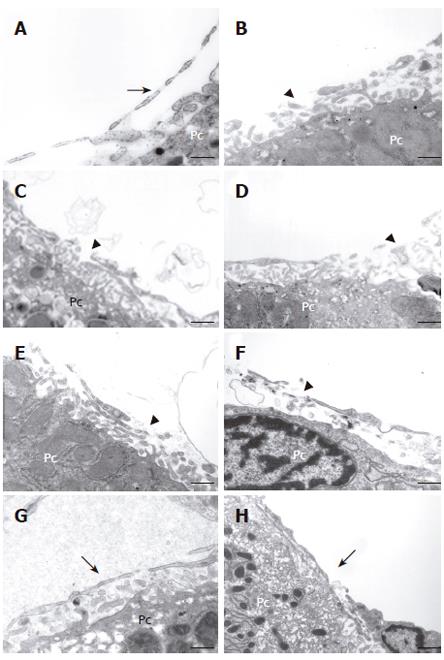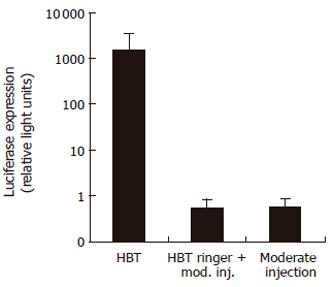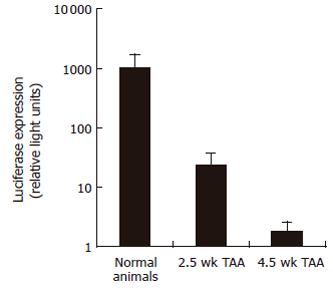Copyright
©2006 Baishideng Publishing Group Co.
World J Gastroenterol. Oct 14, 2006; 12(38): 6149-6155
Published online Oct 14, 2006. doi: 10.3748/wjg.v12.i38.6149
Published online Oct 14, 2006. doi: 10.3748/wjg.v12.i38.6149
Figure 1 400 μg of pGL3-Control plasmid DNA was injected in 5.
25% (volume per animal weight) Ringer to healthy rats by the hydrodynamics based injection (5 to 8 s). 24 h later the liver was excised, the lobes minced and 200 mg samples of each of the four lobes homogenized in reporter lysis buffer and luciferase activity monitored (n = 10).
Figure 2 High magnification electron micrographs of liver sinusoids following hydrodynamic injection.
A: Control image illustrates intact histological relationship between liver sinusoidal endothelial and neighboring liver parenchymal cells (Pc). Note the fenestrated processes (arrow) of endothelial cells; B: Ten minutes after hydrodynamic injections, severe damage of the endothelial lining in the form of gaps is noted (arrowhead). Similar features were observed at 1 (C), 8 (D), 24 (E), and 72 (F) h, i.e, a disrupted endothelial lining with the presence of large structural rearrangement in the form of gaps (arrowheads). The architecture of hepatocytes remained intact when compared to the control. Between seven (G) to ten (H) days post injection, the number of gaps decreased significantly. Interestingly, the hepatic sinusoidal endothelial lining is less fenestrated when compared to the control (arrow). Scale bars, 1 μm.
Figure 3 Scanning electron micrographs of liver sinusoids following hydrodynamic injections.
A: Control liver demonstrates an intact endothelial wall with numerous small pores perforating the endothelial lining (fenestrae) (arrow) and undisrupted bordering parenchymal cells (Pc); B: Numerous gaps (arrowhead) are observed as early as ten minutes after hydrodynamic injections and persist at one (C) and eight (D) hours after injection. From twenty four hours post HBT and onwards the number of gaps (arrowhead) decreases, yet a significant number are still present (E, F). Between seven (G) and ten (H) days following HBT, the endothelial lining reveals similar features as described under Figure 2G-H: i.e., less fenestrated appearance. Scale bars, 2 μm.
Figure 4 400 μg of pGL3-Control plasmid DNA were injected in the following variations: (1) HBT: 5.
25% (volume per animal weight) Ringer solution with plasmid DNA in 5 to 8 s; (2) HBT Ringer + moderate injection: 5.25% (volume per animal weight) Ringer solution in 5 to 8 s followed by 400 μg of plasmid DNA in 500 μL 10 or 30 m later; (3) moderate injection: 500 μL Ringer solution with 400 μg plasmid DNA. Twenty four hours post injection the liver was excised. 200 mg liver sample were then homogenized in reporter buffer and luciferase activity monitored (n = 5).
Figure 5 400 μg of pGL3-Control plasmid DNA was injected in 5.
25% (volume per animal weight) Ringer in 5-8 s to normal rats, and rats injected intraperitoneally (IP) twice weekly with thioacetamide (TAA) for either 2.5 or 4.5 wk. 24 h later the liver was excised and 200 mg samples of the median lobe were homogenized in reporter lysis buffer and the activity of luciferase monitored (n = 5).
Figure 6 400 μg of pGL3-Control plasmid was injected in 5.
25% (volume per animal weight) Ringer in 5-8 s to normal rats, and rats previously injected intraperitoneally twice weekly with thioacetamide (TAA) for 3 wk. Prior to the hydrodynamic injection the rats were fed for 3 wk with either control food or food containing halofuginone at a concentration of 5 ppm. Twenty four hours post HBT the liver was excised and 200 mg samples of the median lobe were homogenized in reporter lysis buffer and the activity of luciferase monitored (n = 5).
- Citation: Yeikilis R, Gal S, Kopeiko N, Paizi M, Pines M, Braet F, Spira G. Hydrodynamics based transfection in normal and fibrotic rats. World J Gastroenterol 2006; 12(38): 6149-6155
- URL: https://www.wjgnet.com/1007-9327/full/v12/i38/6149.htm
- DOI: https://dx.doi.org/10.3748/wjg.v12.i38.6149














